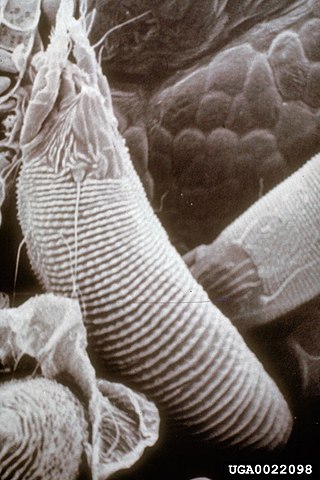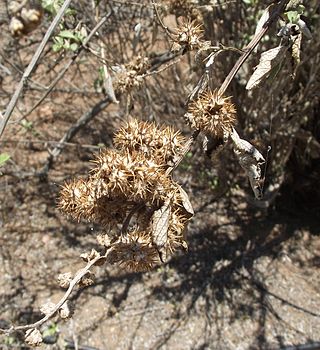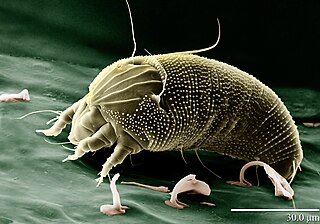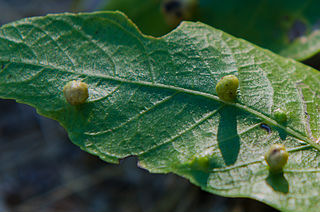
Cecidophyopsis ribis is an eriophyid mite which is best known for being a plant parasite, a pest of Ribes species, the genus that includes gooseberries and blackcurrants. It is commonly known as the blackcurrant gall mite or big bud mite. It feeds on the plants' buds, forming galls, and transmits a virus which causes blackcurrant reversion disease. The mite is a serious pest of blackcurrant crops in Europe, but rarely on other continents.

Artemisia douglasiana, known as California mugwort, Douglas's sagewort, or dream plant, is a western North American species of aromatic herb in the sunflower family.

Aceria chondrillae is a gall-forming deuterogynous eriophyid mite. It is often used as a biological control of the noxious weed Chondrilla juncea, a highly competitive herbaceous perennial composite found in Europe, Asia, Australia and North America.

Baccharis salicifolia is a blooming shrub native to the sage scrub community and desert southwest of the United States and northern Mexico, as well as parts of South America. Its usual common name is mule fat; it is also called seepwillow or water-wally. This is a large bush with sticky foliage which bears plentiful small, fuzzy, pink, or red-tinged white flowers which are highly attractive to butterflies. It is a host plant for the larval stage of the fatal metalmark butterfly, and the adult stage also nectars on the flowers.

Ambrosia chenopodiifolia is a species of ragweed known by the common names San Diego bursage and San Diego bur ragweed. It is native to the Mexican states of Baja California and Baja California Sur, as well as to Orange and San Diego Counties it int US State of California. It is a member of the coastal sage scrub plant community.

Aceria guerreronis, the coconut mite, is an eriophyid mite which infests coconut plantations. It is economically devastating, and can destroy up to 60% of coconut production. The immature nuts are infested and injured by mites feeding in the portion covered by the perianth of the immature nut.

Eriophyes is a genus of acari that forms galls, specially on trees of the family Rosaceae. Some are called blister mites. The blue butterfly Celastrina serotina has been reported to feed on these galls and also on the mites, making it one of the uncommon carnivorous Lepidoptera.

Aceria anthocoptes, also known as the russet mite, rust mite, thistle mite or the Canada thistle mite, is a species of mite that belongs to the family Eriophyidae. It was first described by Alfred Nalepa in 1892.

Aceria fraxinivora, also known as the cauliflower gall mite and the ash key gall, causes the growths, known as galls, found on the hanging seeds or "keys" of the ash (Fraxinus) species.

Aceria tosichella, commonly known as the wheat curl mite (WCM), is a global cereal pest and a vector for spreading and transmission of viruses like wheat streak mosaic virus (WSMV) and wheat mosaic virus (WMoV)

Aculops fuchsiae, commonly known as fuchsia gall mite, is a species of mite in the family Eriophyidae. It feeds on Fuchsia plants, causing distortion of growing shoots and flowers. It is regarded as a horticultural pest.
Hartford Hammond Keifer was a world authority on eriophyid mites. Based in California, he initially studied the local microlepidoptera before turning to mites in 1937.
Eriophyes tulipae, commonly known as the dry bulb mite, is a species of mite in the genus Eriophyes. This mite feeds on members of the lily family, and has damaged garlic crops. At one time, it was also thought to feed on wheat and other grasses, but the wheat curl mite is now regarded as a different species, Aceria tosichella.

Aculops rhois, the poison ivy gall mite, is a species of Eriophyid mite found in North America. They form galls in poison ivy as well as other members of North American Toxicodendron and some species of Rhus.

Aceria elongata, the crimson erineum mite, is a species of eriophyid mite. This microscopic organism induces erineum galls on the upper leaf surfaces of sugar maple, and is known from the east coast of United States and Canada.

Aceria fraxini, the ash bead gall mite, is a species of mites in the family Eriophyidae, the gall mites.

Nalepella, the rust mites, is a genus of very small Trombidiform mites in the family Phytoptidae. They are commonly found on a variety of conifers, including hemlock, spruce, balsam fir, and pine. They sometimes infest Christmas trees in nurseries. Nalepella mites are vagrants, meaning they circulate around the tree; females overwinter in bark cracks. Infested spruce emit a characteristic odour.

Aceria mackiei, previously Eriophyes mackiei, the live oak erineum mite, is an abundant eriophyoid mite that produces leaf-blister galls on coast live oak, interior live oak, huckleberry oak, and canyon live oak. This mite's ability to induce galls in oaks of both the black oak group and the intermediate oak group is unique. The distribution of this arthropod is western North America.

Aceria brachytarsus, formerly Eriophyes brachytarsus, also known as the pouch gall mite or the walnut purse gall mite, is an eriophyoid mite that produces leaf-pouch galls on various species of walnut trees including Juglans californica. The gall produced by this mite initially looks like a bladder gall. This gall has been observed in California, Iran, and Spain.
Aceria cynodoniensis, the bermudagrass mite, is widely distributed, but only infests bermudagrass and its hybrids. It lives and develops under the leaf sheaths of its host plant. Infestations of the mite can cause destructive damage to bermudagrass turf and it is often regarded as a harmful pest.

















